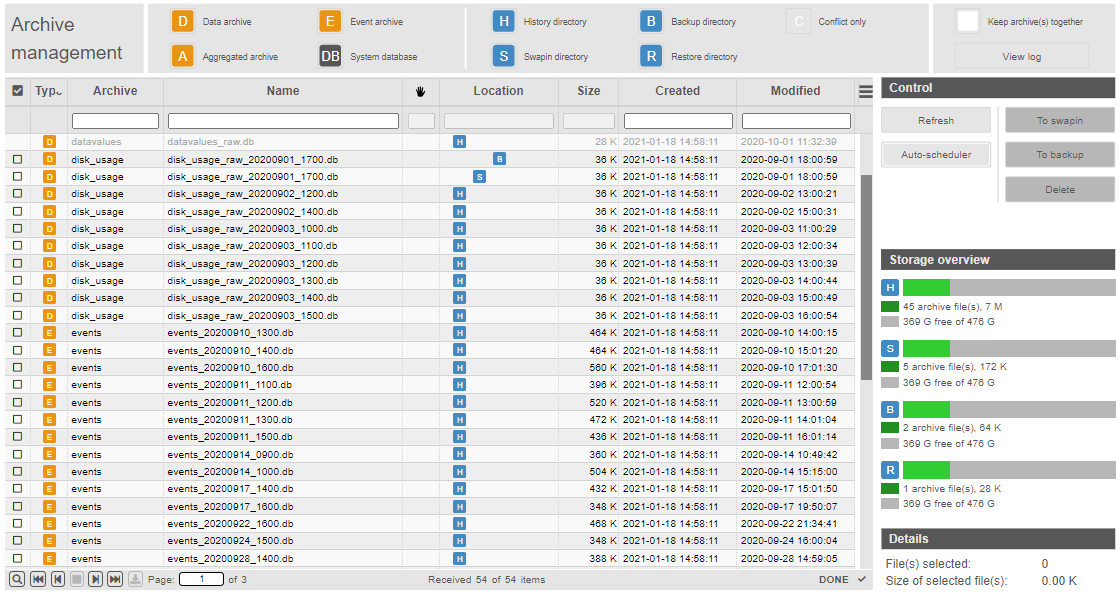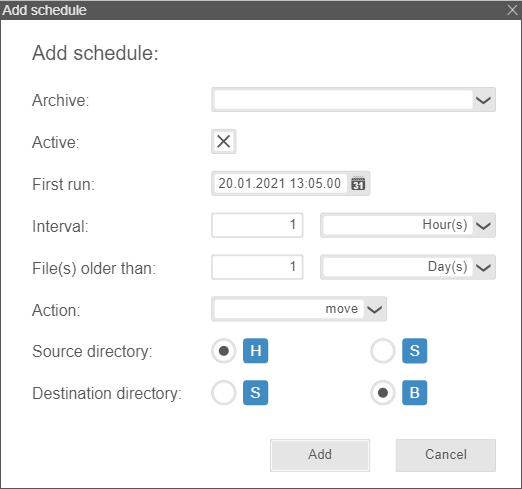Archive Management¶
The archive management is meant for managing historical archive data. The object display offers an overview of all archive files and provides the possibility of creating backups as well as moving or copying archive files to specified directories.

Display¶
Filters
Click the buttons on top of the table for filtering the archives by archive type, location or existing conflicts.
Archive type:
D – Data archive
E – Event archive
A – Aggregated archive
DB – System database
Location:
H – History directory which is used by atvise to store its archive files.
B – Backup directory which can be used for a backup of archive files. atvise scada does not use or know this directory.
S – Swapin directory; atvise scada does not store archive files in this directory and has only read access to swapped in files.
R – Restore directory which can be used like the backup directory for storing and restoring archive files. atvise scada does not use or know this directory.
Hint
Network drives are not supported by the archive management.
To swap archive files in and out correctly, you have to ensure that you use only archives from the currently active project and the archive configuration is still available in the project.
C – Conflict only
Keep archive(s) together – If you sort by a column (e.g. file size), this option groups the corresponding archives. For example, if the biggest file is displayed on top, all files of the corresponding archive are sorted by size below it. The next file (size-wise) of another archive follows after that.
View log – Opens the log view that shows information or error message regarding actions like copying or moving archive files.
Table
The table shows all existing archives that are matching the filter criteria. Furthermore, additional information like file name and size is provided. The respective text fields allow to filter by archive name, file name, manually swapped files ( ) and creation or alteration time. Archives can be selected for further actions with the respective checkboxes.
) and creation or alteration time. Archives can be selected for further actions with the respective checkboxes.
Control
Refresh – Table entries are updated
Auto-scheduler – Allows to configure or edit schedules (see Auto-scheduler)
To swapin – Moves the selected archives to the swapin directory (see Moving/storing data)
To backup – Stores the selected archives in the backup directory (see Moving/storing data)
Delete – Allows to delete selected archives located in the history or swapin directory
Hint
The tables shows the state at the time of the refresh. Archive files that are used at the time of the refresh, are greyed out in the table and cannot be moved, copied or deleted. If files are used after the refresh (e.g. by queries), they are still displayed as available, however, actions like remove will result in an error message.
The atvise server needs up to 60 seconds to process new files after file operations. New file operations shall be avoided during this time.
Storage overview
Shows the memory space available for the drive the respective directory is located on.
Details
Shows the number and size of the currently selected archives.
Configuration¶
Defining directories
It is necessary to specify the backup and restore directory for a proper use of the archive management.
Hint
You have to specify absolute paths on the computer the atserver is running on.
The history directory as well as the swapin directory are automatically defined by atvise. You can change them via the respective entry in the atserver.ini file. See dataDir resp. swapInDir.
Parameter
The object display's behavior and look (e.g. thresholds for disk space, user rights necessary for controls, etc.) can be altered with the respective parameters. Go to atvise builder > Object Displays > Archive Management > Archive Management for a detailed parameter list and description.
Using the display¶
Moving/storing data
Tick the respective checkboxes to select the archives that shall be moved or stored. The appropriate buttons for further actions are enabled in the Control section. Depending on the source or target directory of the respective archive file, the following actions are available:
| to | |||||
|---|---|---|---|---|---|
| HISTORY | SWAPIN | BACKUP | RESTORE | ||
| from |
HISTORY | move | copy / move | - | |
| SWAPIN | - | copy / move | - | ||
| BACKUP | - | copy | - | ||
| RESTORE | - | copy / move | - | ||
Swapin data
Click the To swapin button to move or copy archive files to the swapin directory. You still have (read-only) access to these archives from atvise scada, e.g. via historical queries.
The Auto-Scheduler ignores files that are swapped in from the backup or restore directory using this button. The respective files are indicated by the  symbol and can be only manually moved or deleted.
symbol and can be only manually moved or deleted.
A popup window allows to select whether files shall be copied or moved when swapped in from the restore directory.
Storing data
Click the To backup button to create a backup of the selected archives. These archives are moved or copied to the backup directory and cannot be accessed from atvise scada anymore.
Hint
If you set parameter mode for backup operation to Copy, the archive data is copied and not moved to the backup directory.
It is not possible to delete created backups via the archive management. Therefore, backups can only be copied but not moved to the swapin directory.
Auto-scheduler
Allows to automatically backup or move archives at scheduled intervals.

General
Auto-scheduler active – Activates the scheduler
Report errors – Enables error reporting via server log file or e-mail
E-mail from – The address that sends the report
E-mail to – The address the report is sent to
SMTP – Allows to select a configured SMTP server
Schedules
Shows all schedules which are defined for archives. Use the Add button to define a new schedule. Existing schedules can be edited with a double-click or the Edit button in the last column.

Archive – Specifies the archive that shall be moved or stored
Active – Enables the schedule
First run – Defines when the schedule shall run the first time
Interval – Defines at which intervals the schedule shall be executed
File(s) older than – Defines which archive files shall be moved or deleted
Action – Action that is performed
Copy (if parameter mode for backup operation is set to Copy)
Move
Delete
Source directory – Defines the source directory for the action
Destination directory – Defines the directory to which the archive shall be moved
Solving conflicts
Conflicts only occur if you copy or move archive files on the file system manually and
there are two archive files with the same name in the history data and swapin directory or
there are two archive files with the same name but different sizes (in any directories).
Select and delete one of the involved archive files on the file system in order to solve the conflict.